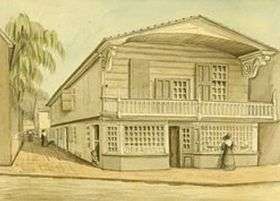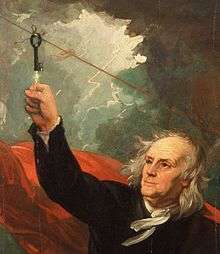Benjamin Loxley

Benjamin Loxley, also known as Benjamin Lockley (December 20, 1720 – October 10, 1801) was a prominent Philadelphia master-builder and carpenter-architect in the American Colonial Period. He was also a well known American patriot army leader. He collaborated with Benjamin Franklin on some of Franklin's electrical experiments, including the kite experiment when Franklin used his house key.
Early life
Loxley was born in Wakefield, England, on December 20, 1720.[1] He was the son of Benjamin Loxley and his wife Elizabeth (Pullen). Loxley immigrated to America when he was fourteen years old and settled in Pennsylvania. He lived with his maternal uncle on a farm near Darby, Pennsylvania, as a farm hand for two years. His uncle then indentured him to W. Joseph Watkins to learn the carpenter's and cabinet making trades.[2]
Loxley was free of his commitments to Watkins in 1742 when he was 22 years old. He married Watkins' sister Jane at that time. He had a set of carpenter's tools and some books on architecture and went about to find work. He soon found several well paid jobs.[2] After Loxley's first wife Jane died on September 22, 1760, he remarried—on September 1, 1761—to Catherine Cox, the eldest daughter of John and Mary (Potts) Cox of Upper Freehold, New Jersey.[1] Loxley then became a partner with carpenter William Henderson.[2] He was successful in his investments and that—with an inheritance—made him a wealthy man.[2]
Mid life
Loxley became a leader of the Carpenters' Company of Philadelphia with Joseph Fox, Robert Smith, and Thomas Nevell.[2] With these three he purchased for the Carpenters' Company the lot on Chestnut Street in 1768 where Carpenters' Hall was eventually built.[3] Loxley volunteered much for the new American movement among the building trades.[2]
He organized the first artillery company of Philadelphia in 1755 and taught the use of cannons and small arms. He was a Captain in the American patriot army[4] under Colonel Samuel Mifflin. In July 1776, Loxley took his company in boats down the Delaware River to an engagement with British gunboats at the Battle of Red Bank. He also marched them to Amboy, New Jersey, on July 21, 1776, to prevent the British army from crossing from Staten Island.[1]

Kite experiment
Loxley was a friend of Benjamin Franklin and helped make many of his electrostatic machines.[1] He assisted Franklin in his electrical experiments. Loxley provided his house key that Franklin used to get lightning from flying a kite in the clouds.[1][5][6] The kite experiment became known as a variant of the "Philadelphia Experiment" of 1752.[7]
Personal life and death
Loxley and his wife Catherine, whom he married in 1761, had a total of twelve children, five of which lived to adulthood.[8][9] He died on October 10, 1801, in Darby, Pennsylvania at the age of 80. He lived at 177 South Second Street in Philadelphia.[10]
Societies and Clubs
- Member of Carpenters' Company of Philadelphia.[2]
- Member of the American Philosophical Society.[2]
- Member of Committee of Safety in 1774-1776.[11]
- Member of Pennsylvania Hospital.[1]
References
Citations
- 1 2 3 4 5 6 "The Spirit of '76". 3–4. Spirit of '76 Publishing Company. 1897.
He was a friend of Franklin, made many of his instruments. assisted in his experiments, and it was the key of the Loxley House which Franklin held on that memorable day when he drew lightning from the skies.
- 1 2 3 4 5 6 7 8 "Biography from the American Architects and Buildings database". Philadelphia Architects and Buildings, part of the American Architects and Buildings database. The Athenaeum of Philadelphia. 2015. Retrieved July 24, 2015.
- ↑ Crissy 1858, p. 11.
- ↑ Griffith 1899, p. 82.
- ↑ "Loxley Court". Historic District, North of Market Street. Independence Hall Association. 2013. Retrieved July 24, 2015.
Loxley himself lived in Number 2, and it was the key from the front door of this house that Benjamin Franklin used in his kite flying experiment with lightning.
- ↑ Harry Kyriakodis. "Franklin's Philadelphia Experiment". Scribd. Retrieved July 24, 2015.
Franklin flying a kite during a lightning storm in the mid-18th century. The key used was reputedly the key for the front door of Loxley's house.
- ↑ Campbell 1999, p. 61.
- ↑ "Jane Loxley, Philadelphia, 1776". M. Finkel & Daughter. 2011. Retrieved July 24, 2015.
- ↑ Cox 1912, pp. 173-174.
- ↑ Rees 1866, p. 123.
- ↑ Coates 1887, p. 36.
Sources
- Campbell, James (1999). Recovering Benjamin Franklin: An Exploration of a Life of Science and Service. Open Court Publishing. ISBN 0812693876.
- Cox, Henry Miller (1912). The Cox Family in America: A History and Genealogy of the Older Branches of the Family from the Appearance of Its First Representative in this Country in 1610. Henry Miller Cox.
- Crissy (1858). Reminiscences of Carpenters' hall: in the city of Philadelphia, and extracts from the ancient Minutes of the proceedings of the Carpenters' company of the city and county of Philadelphia. Crissy.
- Coates (1887). The Carpenters' Company of the City and County of Philadelphia: Instituted 1724. H.C. Coates.
- Griffith, John Thomas (1899). Rev. Morgan John Rhys, "The Welsh Baptist Hero of Civil and Religious Liberty of the 18th Century". Leader Job Print.
- Rees, James (1866). Foot-prints of a Letter Carrier; Or, A History of the World's Correspondence: Containing Biographies, Tales, Sketches, Incidents, and Statistics Connected with Postal History. J.B. Lippincott & Company.